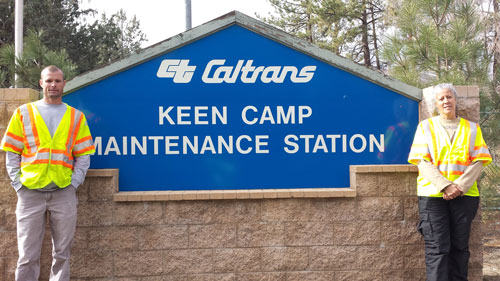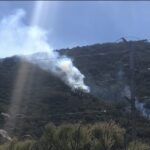
Photo courtesy Caltrans
For Anza resident Scott Firth, the events of last February, are indelibly etched in his memory. An early evening trip down Highway 74 to the desert turned into a life-threatening disaster when he swerved to avoid another motorist and his vehicle cartwheeled 300 feet down the side of a steep ravine.
Firth, who was dressed for anticipated desert warmth, was ejected from his vehicle and lay in freezing temperatures overnight with broken back, shattered lung, broken arms and shattered shoulder, hidden from view of the busy traffic above.
Serendipitously, Caltrans worker Marcus Austin, based in Idyllwild, had been working with his crew that same night on each side of the location where Firth had left the highway. But it wasn’t until he was returning home around 7 in the morning after completing his shift that he noticed skid marks on the recently blacktopped section of highway just past the Pinyon fire station.
“Because the blacktop was fresh, I hadn’t noticed the skid marks that night even though our crew had been driving past that area,” said Austin. “I noticed them the next morning and knew they were recent since I travel that area regularly.”
Austin got out, peered over the side and saw Firth’s truck, pretty badly damaged. “I figured if anyone was in the truck they were probably dead,” he remembered. When he climbed down, he found Firth. “I talked to him, then went back up to flag someone down to call for emergency help.”
There was no cell reception so Austin asked a motorist who had stopped to drive to where he could get or call for help. “I was down there for five minutes and I was shivering uncontrollably,” Austin remembered.
Firth said he believed he would die there. He used his lighter to signal but he was too far down and not visible from above. “I could see car lights on the highway but nobody could see me,” he said. But because Austin, as a Caltrans worker who regularly traveled that road, saw the skid marks from Firth’s vehicle and knew they were recent, he investigated. “A lot of vehicles go over the side on that section of 74,” said Austin. “His truck is still down there.”
“I’m alive all thanks to Marcus,” said Firth. “It’s been six months now and I’m still in a wheelchair, paralyzed in one leg from the knee down. A ligament needs to be replaced. But I am alive and I am grateful.”
Austin said anyone else would have done what he did. But the question is would anyone else have been as familiar with the road and noticed as he did?










